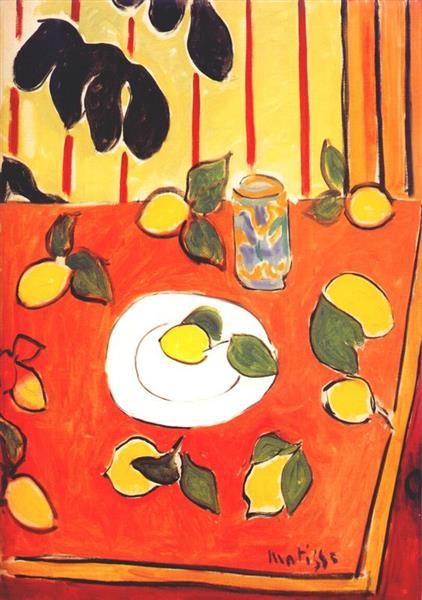Description
The work "Black Philodendron and Lemons" from 1943, signed by master Henri Matisse, is an eloquent testament to the mastery of color and composition that characterize the career of the eminent French painter. This painting stands as a sublime example of Matisse's mature style, where the marriage between form and color is brought to a visual symphony of deceptive simplicity and emotional depth.
In this 43x60 cm composition, Matisse presents a still life that appears simple but is loaded with artistic complexity. The dominant presence of the black philodendron, with its defined and strikingly contoured leaves, creates a vigorous contrast against a vibrant background. The dark leaves stand out like a sort of dark dance that invites the viewer to delve into the delicate balance between shadow and light that Matisse masterfully manages.
In the foreground, bright yellow lemons are distributed almost like musical notes on a score. These fruits not only add a touch of realism but become focal points that guide the gaze through the work. The choice of lemons, with their rough surface and radiant color, vividly contrasts with the black leaves of the philodendron, creating a chromatic oscillation that resonates harmoniously throughout the piece.
The blue-toned background provides a serenity that allows the foreground elements to shine more intensely. This background is not merely an empty space but an extension of the chromatic dialogue that Matisse establishes in the painting, a background that, in its apparent simplicity, supports the composition without distracting attention from the main motifs.
The composition unfolds a balanced interaction between natural and artificial elements, characteristic of Matisse's period in the 1940s, when he was in a process of refining his style. During this time, Matisse had experimented with the simplification of forms and the exaltation of color, moving away from unnecessary details to focus on the visual essence of the work.
Through this work, Matisse also seems to pay subtle homage to his own ability to transform the everyday into sublime art. Where others might see mere leaves and fruits, Matisse sees an opportunity to explore the limits of color and form. This approach is emblematic of his working method, in which every stroke, every curve, and every hue are deliberate and loaded with artistic intent.
"Black Philodendron and Lemons" does not feature human figures, yet it conveys an almost palpable spiritual presence. Matisse, through his chromatic and compositional choices, endows inanimate objects with a life of their own, making the viewer question the boundary between the living and the static, between artifice and nature.
This piece, while it may appear to be a mere still life, is a clear reflection of Henri Matisse's genius, an artist who was capable of transforming the ordinary into the extraordinary, and who remains a central figure in the development of modern art. By observing it closely, one can unravel Matisse's profound understanding of the psychology of color and his ability to create visual spaces that transcend simple representation, opening up to a sensory universe that continues to captivate viewers and critics alike.

